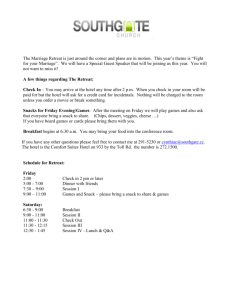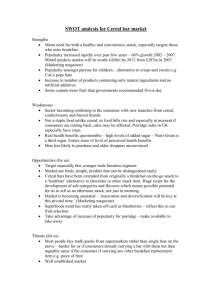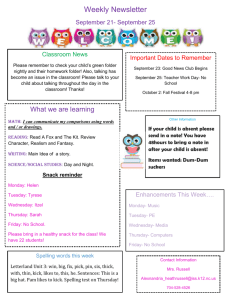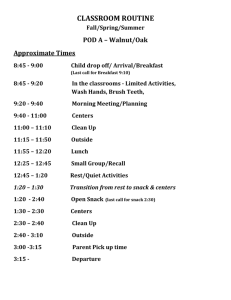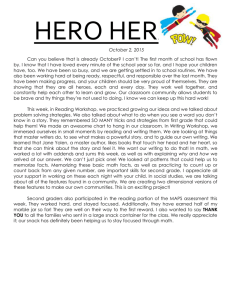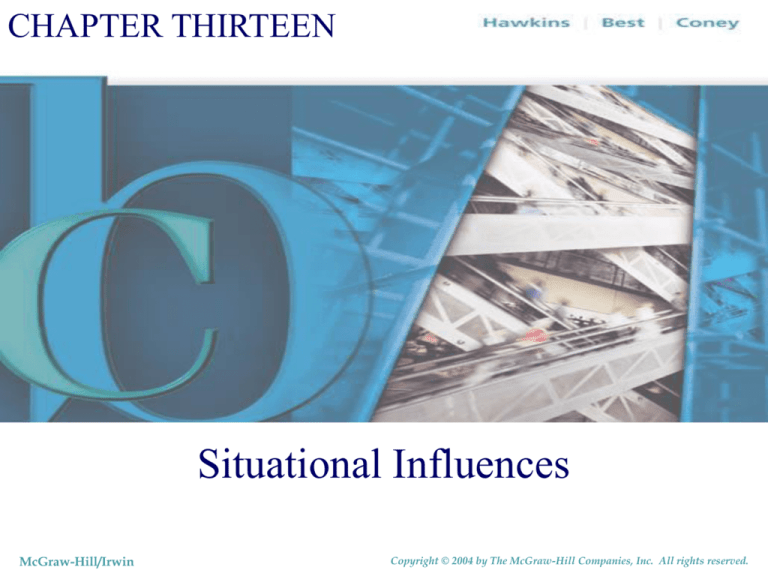
CHAPTER THIRTEEN
Situational Influences
McGraw-Hill/Irwin
Copyright © 2004 by The McGraw-Hill Companies, Inc. All rights reserved.
2
Consumer Decision Process
Ch. 13 - Situational Influences
SITUATIONS
Ch. 14 - Problem Recognition
Problem
Recognition
Ch. 15 - Information Search
Information
Search
Ch. 16 - Alternative Evaluation & Selection
Ch. 17 - Outlet Selection & Purchases
Ch. 18 - Postpurchase Processes
CHAPTER
13
Alternative Evaluation
and Selection
Outlet Selection
and Purchases
Postpurchase
Processes
SITUATIONS
The Role of the Situation…
3
CHAPTER
13
The Nature of Situational Influence
4
• Communication Situation
• What you hear
• Purchase Situation
• When and Where
• Usage Situation
• How
• Disposition Situation
• What now
CHAPTER
13
5
Five Classes of Situational Influence
1.
Physical surroundings include geographical and
institutional location, decor, sounds, aromas, lighting, weather, and
visible configurations of merchandise or other material
surrounding the stimulus object.
2.
Social surroundings
3.
Temporal perspective
4.
Task definition
5.
Antecedent states
considers examples like other persons
present, their characteristics, their apparent roles, and
interpersonal interactions occurring.
may be specified in units ranging
from time of day to seasons of the year.
includes an intent or requirement to select,
shop for, or obtain information about a general or specific
purchase.
conditions
CHAPTER
13
are momentary moods or momentary
6
The Impact of Physical Density
Physical
situation
Shopper
perceptions
Adaptive
strategies
Postpurchase
responses
CHAPTER
13
Increased physical density
Confined, closed-in feeling
Crowded feeling
Alter use of instore information
Shorten planned
purchases
Reduce shopping
time
Store
dissatisfaction
Unpleasant
experience
Reduced
confidence in
purchases
Source: Adapted from G. Harrell, M. Hutt, and J. Anderson, “Path Analysis of Buyer Behavior
under Conditions of Crowding,” Journal of Marketing Research, February 1980, pp.45-51.
Typology of Service Encounters
7
CHAPTER
13
Impact of Background Music
8
Variables
CHAPTER
13
Slow Music
Fast Music
Impact of Social Situations
on Dessert Choices
9
Attribute
Importance
1.0
0.9
0.8
0.7
0.6
0.5
0.4
0.3
0.2
0.1
0.0
0.62
0.42
0.40
0.32
0.30
0.03
Everyday dessert
0.02
While watching
evening TV
Economical
CHAPTER
13
Taste
0.05 0.03
Social gathering
with coffee/tea
Liked by most
Source: J. B. Palmer and R. H. Cropnick, “New Dimension Added to Conjoint Analysis,” Marketing News, January 3, 1986, p. 62.
Temporal Perspectives
and Fruit Preferences
10
Preference
As a part of your breakfast
Most
preferred
#2
#3
Least
preferred
Peach Banana Straw- Orange Plum Apple
Kiwi
Grape
berry
Based on the students surveyed in this study:
• Peaches were most preferred, particularly with breakfast and as a snack.
• Strawberries were most preferred as a supper dessert, and number three overall as a part of
breakfast.
• Oranges and grapes were rated two and three, respectively, as a snack.
CHAPTER
13
Source: Adapted from P. Dickson, “Person-Situation: Segmentation’s Missing Link,” Journal of
Marketing, Fall 1982, pp. 56-64.
Temporal Perspectives
and Fruit Preferences
11
Preference
As a snack during the day
#3
Most
preferred
Least
preferred
#2
Peach Banana Straw- Orange Plum Apple
Kiwi
Grape
berry
Based on the students surveyed in this study:
• Peaches were most preferred, particularly with breakfast and as a snack.
• Strawberries were most preferred as a supper dessert, and number three overall as a part of
breakfast.
• Oranges and grapes were rated two and three, respectively, as a snack.
CHAPTER
13
Source: Adapted from P. Dickson, “Person-Situation: Segmentation’s Missing Link,” Journal of
Marketing, Fall 1982, pp. 56-64.
Temporal Perspectives
and Fruit Preferences
12
Preference
As a supper dessert
#2
Least
preferred
Most
preferred
Peach Banana Straw- Orange Plum
berry
#3
Apple
Kiwi
Grape
Based on the students surveyed in this study:
• Peaches were most preferred, particularly with breakfast and as a snack.
• Strawberries were most preferred as a supper dessert, and number three overall as a part of
breakfast.
• Oranges and grapes were rated two and three, respectively, as a snack.
CHAPTER
13
Source: Adapted from P. Dickson, “Person-Situation: Segmentation’s Missing Link,” Journal of
Marketing, Fall 1982, pp. 56-64.
Task Definition: Evaluative
Criteria in Gift-Giving
13
Benefits “Sought” by Purchaser
CHAPTER
13
Birthday
Wedding
Enjoyability
Uniqueness
Durability
High performance
Usefulness
Innovativeness
Imaginativeness
Receiver’s need for product
Novelty
Durability
Usefulness
Receiver’s need for product
High performance
Enjoyability
Uniqueness
Presence of warranty
Tangibility
Innovativeness
Allows receiver creativity
Prettiness
Source: S. DeVere, C. Scott, and W. Shulby, “Consumer Perceptions of Gift-Giving Occasions: Attribute Sales and Structure,” in Advances
in Consumer Research X, ed. R. P. Bagozzi and A. M. Tybout (Chicago: Association for Consumer Research, 1983), pp. 185-90.
Task Definition: Evaluative
Criteria in Gift-Giving
14
Benefits “Avoided” by Purchaser
CHAPTER
13
Birthday
Wedding
Low quality
Low quality
Unreliability
Lack of receiver desire for product
Lack of thoughtfulness
Gaudiness
No reflection on receiver’s personality
Lack of tastefulness
Disliked by friends and family
Lack of style
Inconvenience
Lack of receiver desire for product
Lack of thoughtfulness
Gaudiness
Lack of style
Unreliability
Lack of tastefulness
Disliked by friends and family
Inconvenience
Inappropriate for occasion
Ritual Situations
15
• A socially defined occasion that triggers a set
of interrelated behaviors that occur in a
structured format and that have symbolic
meaning
• Some examples:
• Social events
• Holidays
• Injurious consumption (Consumer Insight 13-1)
CHAPTER
13
How Situations Might Influence
Choice of a Restaurant
16
CHAPTER
13
Situational
Influence
Description of
the Situation
1. Physical
It is very hot and your air
conditioning isn’t working
2. Physical
You’re downtown Christmas
shopping and the stores and
streets are very crowded.
3. Social
Your fiancée's parents are going
to take you out for dinner and ask
you to pick the restaurant.
4. Social
Your neighbor comes over to visit,
you are having a pleasant chat, and
you discover it is time for lunch.
5. Temporal
You plan to go to a show at
7:30 p.m. It is 6:30 p.m. now.
Type of
Restaurant Chosen
How Situations Might Influence
Choice of a Restaurant
17
CHAPTER
13
Situational
Influence
Description of
the Situation
6. Temporal
You want to have an evening meal
with the family when not rushed
for time.
7. Task
It’s your parents’ 25th wedding
anniversary and you want to take
them out to dinner.
8. Task
Your spouse won’t be home for
dinner and you are wondering what
to feed the children.
9. Antecedent
You are too tired to cook dinner
because you have had a very
fatiguing day at the office.
10.Antecedent
You have just finished a tough
semester and you’re in the mood
to really reward yourself.
Type of
Restaurant Chosen
Consumer Insight 13-1
18
• Do you agree that binge drinking by
college students is a form of ritual
behavior?
• Utilizing the “fact” that binge drinking
among college students is a ritual
behavior, develop a commercial
minimizing the negative aspects of the
behavior.
CHAPTER
13
Use Situations and Product Positioning
19
CHAPTER
13
Person-Situation Segments
for Suntan Lotions
20
CHAPTER
13



